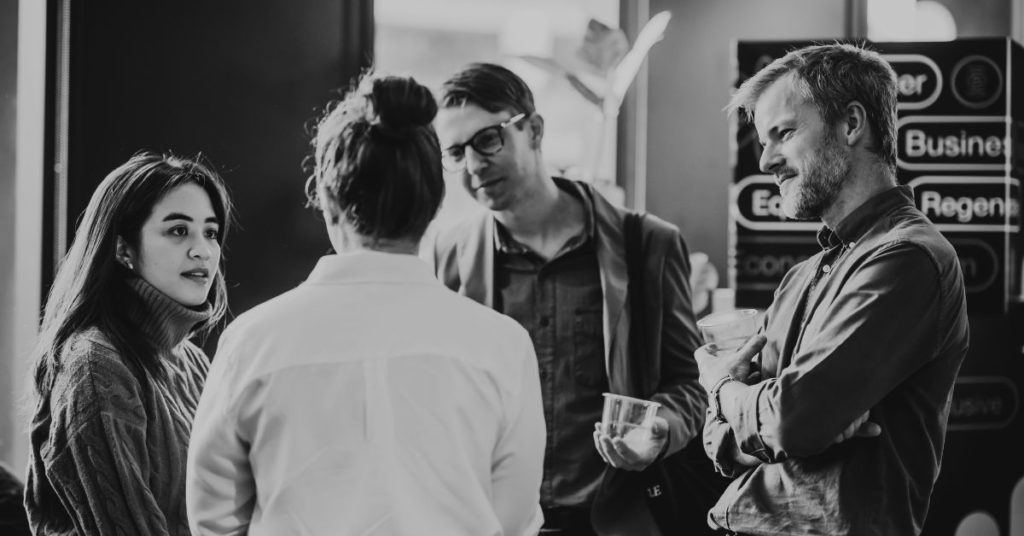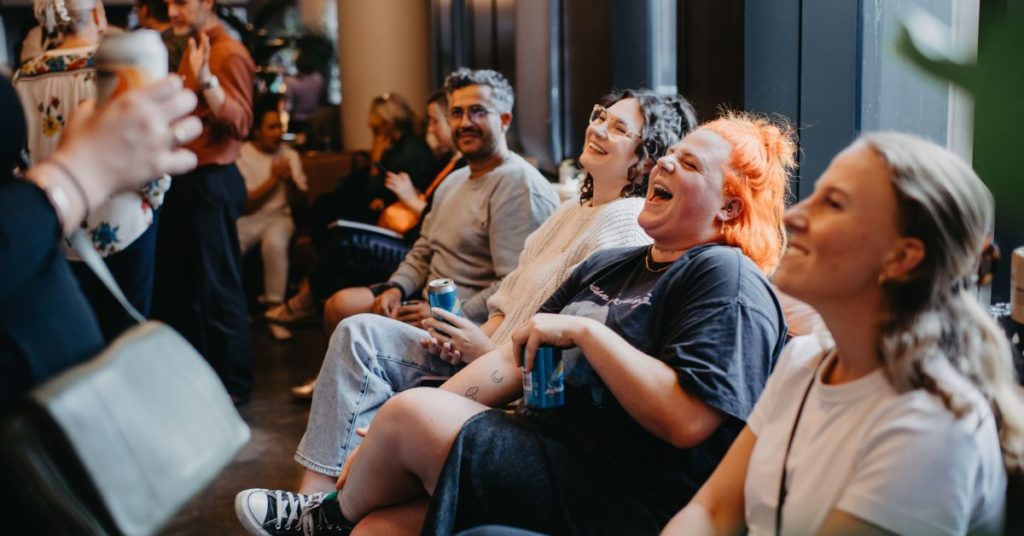By Carmen Hawker
The story of then
It was New Year’s Day, 2005, and Jay Coen Gilbert was celebrating with his colleague and friend Bart Houlahan when he broke the news that he had just sold his business, basketball-apparel company AND1.
This decision did not come out of the blue. Coen Gilbert had spent several years in a period of intense introspection, triggered by the events of 9/11 and shortly followed by the death of several loved ones.
Reflecting on how to be of greatest service and inspired by the stories of socially and environmentally conscious brands like Patagonia, Newman’s Own and Ben & Jerry’s, he announced he would start an organisation designed to challenge the reign of shareholder primacy and hold companies publicly accountable for how they benefited workers, communities, the environment, and customers.
Alongside Houlahan, Coen Gilbert brought former classmate and friend Andrew Kassoy into the fold in 2006, kicking off the idea that eventually became B Lab: a not-for-profit that analyses and verifies businesses who walk the talk on social and environmental performance, legal accountability and public transparency, and certifies them as B Corporations where the B stands for ‘benefit for all’.
The story of now
Fast forward to now and what started out as a small group of passionate visionaries has incrementally grown to a global network of more than 6,000 businesses, across 160+ industries, employing more than half a million people, and impacting millions more. And that is the origin story of this movement; a movement made up of individual businesses brought together by a common purpose and plenty more.
As the movement reaches its tipping point and becomes a force too big to ignore, the question becomes whether or not this narrative will help us truly realise our goal of transforming the global economy and making every business a force for good?
With insights from purpose-driven creative agency and proud B Corp Digital Storytellers, we unpack why the business for good movement must powerfully tap into the stories that bind us together and forge a storytelling ecosystem that will sustain and grow the movement for years to come.
Thank you to Digital Storytellers for helping us tell our story
Using story to power systems change
We live in a time where there is a clear need for transformation – of how we conduct business, how we consume, how we treat others, and how we treat the natural environment. But transformation does not happen overnight or by accident. It takes vision, it takes leadership and it takes collective action.
As an ancient craft that taps into how our human brain digests and retains information, storytelling looms as the heart-centred, science-backed and purpose-driven approach we need to change the systems that are no longer working for us, if they ever did.
Stories are well known for engaging hearts and captivating minds. With a structure that activates neural mechanisms capable of moving us to tears, changing our attitudes, opinions and behaviours, and inspiring us to take action, they can even change our brains, often for the better.
An effective way to build collective narratives and bring together members of a movement with greater meaning, stories offer us a shared language and clarity of purpose that is a critical part of systems change. Giving us all the chance to interact and connect in meaningful ways, while reflecting back a more expansive vision for the world, as it is and as it could be.

Image: Canva
Through their many years of shaping and sharing impact stories, Digital Storytellers never cease to be amazed by the ability of a story — or collection of stories — to ignite a sense of belonging and pride. Stories rarely fail to promote innovation and creativity, and they heighten our sense of involvement by helping us see the different roles we have to play in the broader movement.
For these reasons, storytelling is incredibly effective at powering systems change, enabling movements to reimagine and regenerate themselves from the inside out.
“Stories make, prop up, and bring down systems. Stories shape how we understand the world, our place in it, and our ability to change it.”
— Ella Saltmarshe (SSIR)
Creating the story of future
Over the past 15+ years, and especially since 2020, we have witnessed a profound shift in what it means to do good business. The rapid growth of the B Corp movement is testament to that, as are the burgeoning social enterprise and purpose-driven business sectors.
Naturally, with rapid growth comes rapid learning and new challenges. The reality is that this movement doesn’t look like it did at the beginning when the ‘freshman class of 19’ first certified in 2007. And that’s a good thing.
However, balancing the movement’s record growth with the need to maintain and uphold the rigour of our standards has prompted a marked evolution in what it means to be a B Corp. This is not something the B Corp movement shies away from. In fact, we welcome it. Scrutiny is to be expected; it is the path to greater accountability, change and impact. And no one said the work of transforming the global economy was going to be easy.
It’s more clear than ever that there is no ‘one’ way to do business for good, just as there is no ‘one’ way to be a B Corp.
While the B Corp movement certainly has elements that bind us together — from a shared commitment to benefit all, and a dedication to radical transparency and a keen awareness of our interdependence — our strength, in many ways, is in our diversity and difference.

Photography by Tizia May
This is bigger than the ‘B’
The need for a more regenerative, kind and equitable economy is bigger than B Corps. B Corps are important, but not enough. We need to change the rules of the game, so all businesses behave with purpose, accountability and transparency.
Right now we have the chance to redefine business as usual and use stories to create a memorable, compelling and galvanising vision of the world and a roadmap for the world as it could be.
At this critical juncture in the movement’s history, the ability to tell a cohesive, compelling and collective story stands in the way of our continued growth and success.
Instead, a truly healthy, growing movement is able to generate its own meaningful stories from the many complex interactions among its diverse members, and it doesn’t shy away from that complexity.
Right now, we are being called to embrace the tension inherent in scaling and develop an infinite narrative capable of growing as we do.
Rather than pouring our finite resources into following a linear pathway to systems change that involves travelling from one campaign to the next, or one milestone to the next — we must evolve towards an ‘ecosystem approach’ that will enable us to stay true to the community’s roots and create space for plurality as we grow.

Photography by Tizia May
The ‘ecosystem approach’ to storytelling
The ecosystem approach, as it applies to storytelling, involves members of the community at every level, developing the ability to craft and share their own ‘enterprising stories’ and speaking their truths.
An ecosystem of stories becomes far more powerful when we make room for more voices at the table. Drawing on the First Nations concept of deep listening and respect through the process of ‘Dadirri’, we can use story to consciously and inclusively embrace and centre perspectives from the edge in order to grow the movement beyond the ‘usual suspects’.
Allowing a collective narrative to emerge from the ground up avoids one that is delivered from the top-down, reinforcing the position of those who already hold power and privilege.
“Isolated stories and top-down narratives cannot inspire a movement over the longer term. There is no ‘one narrative’, no ‘one storyteller’, nor one way of seeing or being in this world. That’s what makes it so rich, and it’s also what makes it so complex, dynamic and challenging to navigate.”
— Digital Storytellers
With an ecosystem approach, stories can provide an evergreen backdrop to the work of transforming the global economy; one that reinforces the movement’s interdependence and gathers momentum along the way.
It works because each story attracts and engages more people who share that similar vision for the future. This ‘buy-in’ leads to meaningful action and more stories, which in turn, inspires more people and creates more stories. What we start to see is “an almost super highway of possibility,” sparking forward momentum, circular abundance and infinite possibilities. And that is the power of the storytelling ecosystem.

Photography by Tizia May
Are you ready to transform the global economy through story?
Just like brushing our teeth or charging our phones, storytelling is not something that we can just do once, and never again. It needs to be an indelible and non-negotiable part of the culture, and done by everyone at every level and at every opportunity.
Each individual story — whether it’s why your business started, how you create impact or a mistake that you’ve made — takes on a life of its own, creating infinite opportunities for empathy and connection in its wake.
They don’t have to be ‘inspirational’, mind-blowing or aspirational. In fact, sometimes the more mundane or ‘everyday’ a story is, the more effective it can be for connecting with your community in relatable and galvanising ways. In essence, it’s about matching the story you want to tell, with the stories that the community needs to hear, and letting them coalesce to create the impact or systems change you are seeking.

Photography by Tizia May
Making business for good an unstoppable force
Now is the time to build momentum between the small, everyday moments of doing better business and the big, defining crescendos of the movement (like B Corp Month).
To drive change and galvanise purpose-driven businesses into an unstoppable force for good, as a movement we must continue to and amplify our efforts to:
- Create and hold spaces for deeply held stories to surface
- Listen to multiple perspectives and seek out ‘unusual suspects’
- Map the field of stories so that patterns and commonalities may emerge, as well as key points of difference
- Build the capacity of our communities to tell their own stories
- Share stories that are meaningful and inspire action
- Co-create storytelling strategies that adapt to new conditions as they emerge

Download Digital Storytellers’ Story Mapping Toolkit and begin to discover your field of stories.
Why now
Start to imagine what could be possible if we truly make space for each and every story, each and every business, and at each and every level. Done right, we will be bearing witness to an increasingly rich and perpetual tapestry of much-needed change.
Because no matter how small or seemingly insignificant our stories may seem — the stories of the thousands of businesses, hundreds of thousands of workers and millions of stakeholders in this community added together cannot help but create gigantic ripple effects of impact.
And this ecosystem of circular abundance and heart-centred stories may just hold within it the power to transform the global economy and the world we live in.
By Carmen Hawker, with thanks to Digital Storytellers — a purpose-driven creative agency on a mission to democratise storytelling and create a better narrative for the world.

